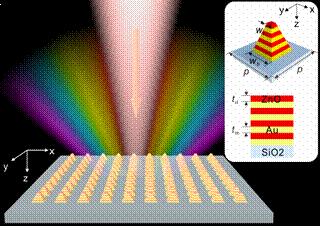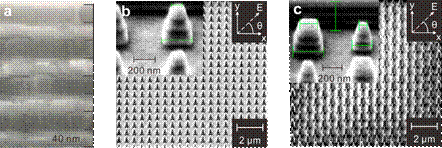On November 5th, a paper titled Full-Color Enhanced Second Harmonic Generation Using Rainbow Trapping in Ultrathin Hyperbolic Metamaterials was published in Nature Communications. The paper is a collaborative work by Professor Xiong Wei, Professor Wang Jian, and Professor Chen Lin from the Wuhan National Laboratory for Optoelectronics (WNLO), Huazhong University of Science and Technology, and Professor Zhang Qing from the College of Engineering, Peking University.
Nonlinear optics deals with light interaction with materials beyond the simple description of linear relationships between the induced polarization and incident field, which has widespread applications in laser technology, microscopy, and material science. As the high-order term between materials’ polarizability and pumping, the nonlinear optical responses are usually weak and thus require the stringent phase-matching condition or quasi-phase-matching condition and sufficient light-matter interaction length to boost the nonlinear light generation. Thus, searching for more efficient nonlinear materials or the new physical mechanism to boost materials’ nonlinearity becomes an essential branch in modern optics.
Metasurfaces have provided a promising approach to enhance the nonlinearity at the subwavelength scale. Plasmonic metasurfaces can squeeze light into a deep subwavelength volume and thus greatly enhance nonlinear harmonic generation, but the Ohmic loss and the weak penetration of the field inside the metal significantly limits the conversion efficiency. In that sense, all-dielectric low-loss nanostructures are widely explored, as high-quality Mie resonances supported therein can compress the pump light to excite nonlinear processes and meanwhile efficiently extract nonlinear signals serving as the nanoantenna. Other approaches such as hybrid nonlinear metasurfaces combining a resonant metallic structure with another dielectric or novel nonlinear material have also been proposed, further boosting the frequency conversion processes. Nevertheless, those approaches based on high-quality resonance intrinsically suffer from the narrow bandwidth, which limits broadband nonlinear applications.
In the paper, the authors report broadband enhanced second-harmonic generation in patterned multilayer hyperbolic metamaterial arrays. Hyperbolic metamaterials based on multilayer metal/dielectric structures allow the direct access of the mode with large momentum. When the frequency approaches the cut-off frequency of the mode, slow light is realized with the group velocity approaching zero and light is localized at a subwavelength scale. For the taper hyperbolic metamaterials with continuously variant widths, light with different frequencies in a broad bandwidth is trapped at different widths corresponding to different cut-off frequencies (termed as ‘rainbow trapping’). For a proof-of-concept demonstration, the authors fabricate a nanostructured Au/ZnO multilayer, and enhanced second harmonic generation can be observed within the visible wavelength range (400-650 nm). The enhancement factor is over 50 within the wavelength range of 470-650 nm, and a maximum conversion efficiency of 1.13×10-6 is obtained with a pump power of only 8.80 mW. The results offer an effective and robust approach towards the broadband metasurface-based nonlinear devices for various important technologies.

FIG.1 Schematic of a full-color second harmonic generator made of TP-HMMs.

FIG.2 (a) SEM image of the vertical cross-section of the unpatterned Au/ZnO multilayer. (b) SEM image of the single-pillar TP-HMM. (c) SEM image of the dual-pillar TP-HMM.

FIG.3 (a) Testing setup. (b) Broadband SHG for taper-patterned Hyperbolic metamaterials.
Li Junhao, a doctoral student in WNLO, is the first author of this paper. Dr. Hu Guangwei from National University of Singapore, and Associate Prof. Shi Lina from Institute of Microelectronics, Chinese Academy of Sciences, are the first co-authors. Prof. Chen Lin, Prof. Zhang Qing, and Prof. Xiong Wei are the corresponding co-authors. This work has been granted support from National Natural Science Foundation of China (Grant Nos. 11674118, 12074137, 61774067, 51991340), National Key R&D Program of China (Grant No. 2018YFB2200200, 2017YFA020570), State Key Laboratory of Advanced Technology for Materials Synthesis and Processing of Wuhan University of Technology, and State Key Laboratory of Artificial Microstructure & Mesoscopic Physics of Peking University.
Paper link: https://doi.org/10.1038/s41467-021-26818-3
Written by: Chen Lin, Gou Bingbing
Edited by: Scott, Peng Yumeng
